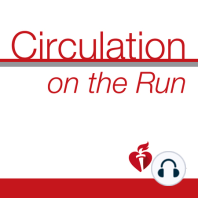17 min listen
Circulation September 7, 2021 Issue
ratings:
Length:
29 minutes
Released:
Sep 7, 2021
Format:
Podcast episode
Description
This week's episode features special Guest Host Mercedes Carnethon, as she interviews author Sung-Min Cho and Associate Editor Marc Ruel as they discuss the article "Cerebrovascular Events in Patients with Centrifugal-Flow Left Ventricular Assist Devices: A Propensity Score Matched Analysis from the Intermacs Registry." Dr. Carolyn Lam: Welcome to Circulation on the Run, your weekly podcast summary and backstage pass to the journal and its editors. We're your co-hosts. I'm Dr. Carolyn Lam Associate Editor from the National Heart Center and Duke National University of Singapore. Dr. Greg Hundley: And I'm Dr. Greg Hundley Associate Editor, Director of the Pauley Heart Center at VCU Health in Richmond, Virginia. Well, Carolyn, this week's feature, we're going to look at centrifugal flow, left ventricular assist devices and cerebrovascular events. But before we get to the feature, how about we grab a cup of coffee and jump into some of the other articles in the issue? And maybe how about I go first? Dr. Carolyn Lam: All right. I got my coffee. Dr. Greg Hundley: So my first paper comes from Professor Dali Luo from Capital Medical University. And it's pertaining to calsequestrin-1. So calsequestrin-1, and calsequestrin-2 isoforms buffer calcium and regulate its release from the sarcoplasmic reticulum of skeletal and cardiac muscle. Human inherited diseases associated with mutations of calsequestrin-1 or 2 include malignant hyperthermia and environmental heat stroke and catecholamingergic polymorphic ventricular tachycardia. However, patients with hypothermia, environmental heat stroke events often suffer from an arrhythmia for which the underlying mechanism remains unknown. Dr. Carolyn Lam: Wow. Okay. And what did the current paper do and find? Dr. Greg Hundley: Great, Carolyn. So what the authors found, calsequestrin-1, the skeletal isoform of it is indeed expressed in cardiomyocyte sarcoplasmic reticulum for mirroring in human hearts, mostly presenting as a polymeric form and interacting with the ryanodine 2 receptor in ventricles. Second, calsequestrin-1 deficiency cause sinus tachycardia in basal conditions. And this is a novel finding which may be associated with sinus beat regulation and ventricular arrhythmia as an independent arrhythmogenesis if a high concentration of volatile anesthetics are used. Next, these volatile anesthetics and heating to 41 degrees C can directly induce calsequestrin-1 oligomerization, thereby causing enhancement of diastolic calcium leak and premature calcium transience through a reduced regulatory effect of calsequestrin-1 on ryanodine 2 activity. And so Carolyn, this novel mechanism underlying the arrhythmia occurring in patients with malignant hypothermia or environmental heatstroke episodes may provide different strategies for heart disorders as an independent profile in these syndromes. And finally, the finding of calsequestrin-1 confirmational change induced by triggers in those with malignant hyperthermia and environmental heatstroke could lead to novel therapeutic approaches to prevent these types of episodes. And that may also very, very useful in treatment of heatstroke. Dr. Carolyn Lam: Wow. Thanks Greg. Well, moving from this preclinical world to a very common clinical question of the diagnosis of acute myocardial infarction. Now we know that in patients presenting to the emergency department with symptoms suggestive of an MI, the European Society of Cardiology zero and one hour algorithm is recommended by current ESC NSTEMI guidelines with a class one recommendation. Now, what this does is it combines a very high safety for early rule-out and high accuracy for rule-in allowing a definite triage of about 70 to 75% of patients using the zero in one hour sample. Dr. Carolyn Lam: However, what is the most appropriate management of the 25 to 30% of patients who remain in the gray observed zone? So this is the question that the current paper addresses. Now to answer this, we also need some
Released:
Sep 7, 2021
Format:
Podcast episode
Titles in the series (100)
Circulation January 24, 2017 Issue: Circulation Weekly: Your Weekly Summary & Backstage Pass To The Journal by Circulation on the Run
